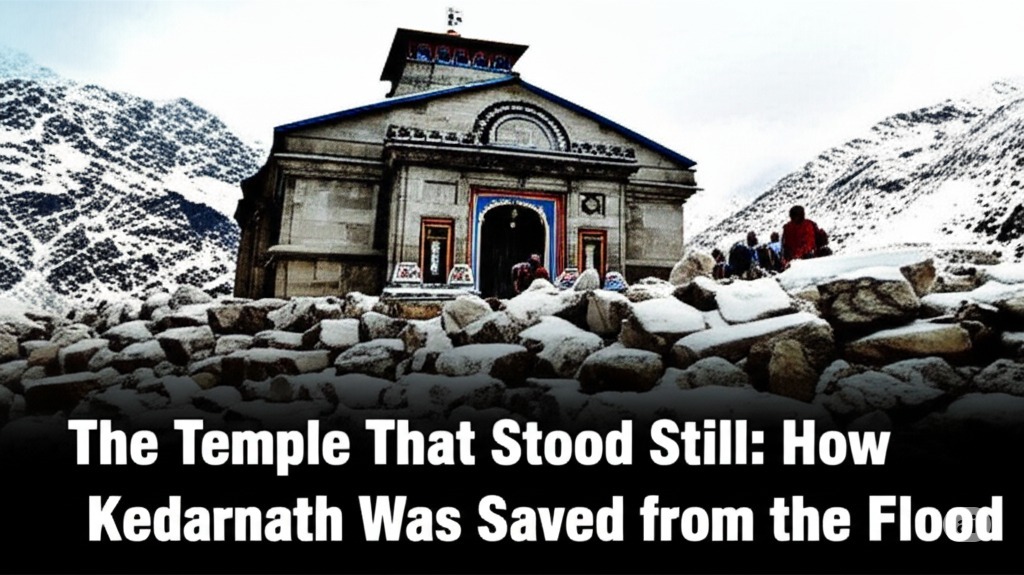In June 2013, a devastating tragedy struck the mountains of Uttarakhand, India. Unprecedented rainfall caused massive flash floods and landslides, washing away entire towns, bridges, and roads. At the heart of this destruction was the sacred valley of Kedarnath. The raging waters of the Mandakini river, fed by the bursting of the Chorabari glacial lake, swept through the area with unimaginable force.
Everything around the Kedarnath Temple—hotels, shops, and homes—was wiped away, leaving behind a vast field of mud and debris. Yet, amidst the complete devastation, the ancient temple of Lord Shiva stood firm, almost untouched.
How did this happen? How did a temple, thousands of years old, survive a force of nature that modern structures could not? The answer is a powerful mix of brilliant ancient engineering and what many believe to be a touch of divine intervention.
Let's explore the key reasons behind this incredible survival story.
1. The Wisdom of Ancient Builders: A Masterclass in Location and Design
The survival of the Kedarnath Temple wasn't just a matter of luck. The ancient builders who constructed it possessed a deep understanding of the region's geography and climate.
-Strategic Location: The temple is not built right on the riverbank but on a large, elevated piece of land left behind by an ancient glacier. This high and stable ground provided a much stronger foundation than the surrounding riverbed where most modern construction took place.
-Superior Construction: The temple is made of massive, heavy stone slabs. These stones are not held together by cement. Instead, they are fitted together using an interlocking technique, almost like a giant puzzle. This method makes the structure incredibly strong and flexible, allowing it to withstand immense pressure and vibrations without collapsing. The sheer weight of the stones kept it anchored to the ground.
-Smart Orientation: The temple is built in a North-South direction. The floodwaters came from the East, crashing against the side of the temple. This meant the water hit a narrower, stronger profile rather than a wide, flat back wall. This simple but brilliant directional placement significantly reduced the force of the water's impact.
2. The Divine Shield: The Story of the "Bhim Shila"
While science and engineering explain much of the temple's resilience, there is one event from that day that millions of devotees consider a true miracle.
As the wall of water, mud, and giant boulders rushed towards the temple, a single, massive boulder was washed down from the mountain above. In what seemed like a divinely guided moment, this huge rock stopped just a few feet behind the temple, directly in the path of the flood's main current.
This rock, now known as the Bhim Shila or Divya Shila (Divine Rock), acted as a giant shield. It split the ferocious torrent of water into two streams, diverting the flow and the deadly debris around the sides of the temple instead of directly into its back wall. Had this rock not stopped exactly where it did, the force of the water would have likely hit the temple's rear wall head-on, causing catastrophic damage.
Today, pilgrims who visit Kedarnath make it a point to bow before this sacred rock, which stands as a silent guardian behind the temple.
A Symbol of Resilience
The story of how Kedarnath Temple survived the flood is more than just an architectural marvel. For believers, it is a testament to the enduring power of faith. For engineers, it is a lesson in building in harmony with nature.
The temple stands today not just as a place of worship, but as a powerful symbol of hope and resilience. It reminds us that even in the face of the most destructive forces, things built with wisdom, strength, and a little bit of grace can endure.
Frequently Asked Questions (FAQ)
1. What is the Bhim Shila or Divya Shila?
The Bhim Shila (or Divya Shila) is the name given to the large boulder that came to a stop directly behind the Kedarnath Temple during the 2013 flood. It acted as a shield, diverting the floodwaters and protecting the main structure from being destroyed.
2. How old is the Kedarnath Temple?
While the exact age is debated, historical and archaeological evidence suggests the current structure is at least 1,200 years old, believed to have been built by the great philosopher Adi Shankaracharya in the 8th century A.D. Legends, however, trace its origins back to the Pandavas from the Mahabharata era, thousands of years ago.
3. Was the temple completely undamaged in the flood?
The main temple structure miraculously survived. However, it was partially buried in several feet of mud and debris. The surrounding complex and the town were almost completely destroyed. The temple required extensive cleaning and restoration before it could be reopened for pilgrims.
4. What makes the temple's construction so strong?
The temple's strength comes from its use of massive, locally sourced stone slabs that are interlocked without cement. This ancient construction technique, combined with its heavy weight and placement on stable ground, makes it incredibly durable.
5. Is it safe to visit Kedarnath now?
Yes. Following the 2013 tragedy, the government has undertaken massive reconstruction and infrastructure development projects. New, safer pathways have been built, and regulations are in place to manage the flow of pilgrims, making the journey much safer than before.




